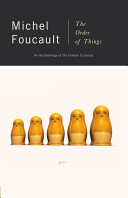The Universality of Analogy
This reversibility and this polyvalency endow analogy with a universal field of application. Through it, all the figures in the whole universe can be drawn together. There does exist, however, in this space, furrowed in every direction, one particularly privileged point: it is saturated with analogies (all analogies can find one of their necessary terms there), and as they pass through it, their relations may be inverted without losing any of their force. This point is man: he stands in proportion to the heavens, just as he does to animals and plants, and as he does also to the earth, to metals, to stalactites or storms. Upright between the surfaces of the universe, he stands in relation to the firmament (his face is to his body what the face of heaven is to the ether; his pulse beats in his veins as the stars circle the sky according to their own fixed paths; the seven orifices in his head are to his face what the seven planets are to the sky); but he is also the fulcrum upon which all these relations turn, so that we find them again, their similarity unimpaired, in the analogy of the human animal to the earth it inhabits: his flesh is a glebe, his bones are rocks, his veins great rivers, his bladder is the sea, and his seven principal organs arc the metals hidden in the shafts ofmines[11]. Man's body is always the possible half of a universal atlas. It is well known how Pierre Belon drew, and drew in the greatest detail, the first comparative illustration of the human skeleton and that of birds: in it, we see the pinion called the appendix which is in proportion to the wing and in the same place as the thumb on the hand; the extremity of the pinion which is like the fingers in us ...; the bone given as legs to the bird corresponding to our heel; just as we have four toes on our feet, so the birds have four fingers of which the one behind is proportionate to the big toe in us[12].
So much precision is not, however, comparative anatomy except to an eye armed with nineteenth-century knowledge. It is merely that the grid through which we permit the figures of resemblance to enter our knowledge happens to coincide at this point (and at almost no other) with that which sixteenth-century learning had laid over things.
Notes:
Folksonomies: analogy similarity
Taxonomies:
/business and industrial/company/merger and acquisition (0.466577)
/health and fitness/disease/infertility (0.422875)
/science/medicine/embryology (0.417349)
Keywords:
polyvalency endow analogy (0.932933 (positive:0.882775)), particularly privileged point (0.783415 (positive:0.260938)), veins great rivers (0.758530 (neutral:0.000000)), universal field (0.572162 (positive:0.882775)), necessary terms (0.553682 (negative:-0.367224)), sixteenth-century learning (0.538748 (neutral:0.000000)), comparative illustration (0.535962 (neutral:0.000000)), principal organs (0.534847 (neutral:0.000000)), human animal (0.534378 (neutral:0.000000)), big toe (0.532301 (neutral:0.000000)), human skeleton (0.531599 (neutral:0.000000)), Pierre Belon (0.530504 (neutral:0.000000)), possible half (0.529750 (neutral:0.000000)), nineteenth-century knowledge (0.528240 (negative:-0.258537)), universal atlas (0.524961 (neutral:0.000000)), comparative anatomy (0.522579 (negative:-0.258537)), proportion (0.430365 (positive:0.224432)), analogies (0.425490 (negative:-0.283861)), face (0.419078 (neutral:0.000000)), pinion (0.413563 (neutral:0.000000)), fingers (0.396795 (neutral:0.000000)), universe (0.387679 (neutral:0.000000)), metals (0.386416 (neutral:0.000000)), figures (0.384805 (neutral:0.000000)), relations (0.383524 (negative:-0.287525)), earth (0.382393 (neutral:0.000000)), reversibility (0.375856 (positive:0.882775)), Universality (0.373260 (positive:0.882775)), sky (0.371722 (neutral:0.000000)), birds (0.367182 (neutral:0.000000))
Entities:
Pierre Belon:Person (0.845756 (neutral:0.000000)), principal:JobTitle (0.747474 (neutral:0.000000))
Concepts:
Universe (0.958437): dbpedia | freebase
Human anatomy (0.900950): dbpedia | freebase
Planet (0.843399): dbpedia | freebase | opencyc
Skeleton (0.756687): dbpedia | freebase | opencyc
Anatomy (0.739736): dbpedia | freebase
Earth (0.714357): dbpedia | freebase
Toe (0.684940): freebase | opencyc | dbpedia
Analogy (0.679940): dbpedia | freebase | yago





